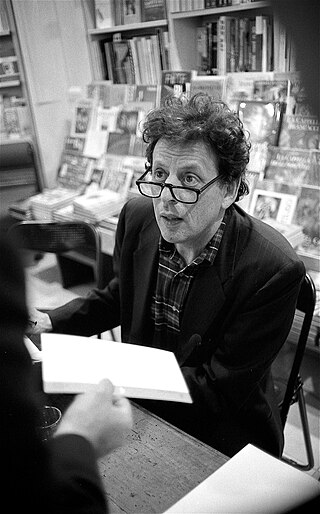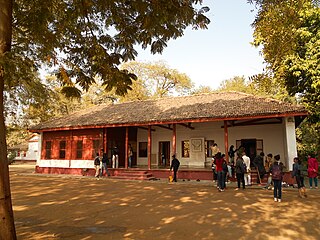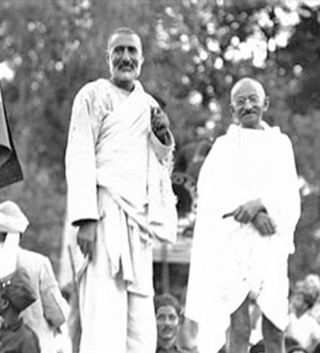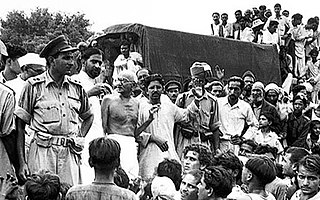
Mohandas Karamchand Gandhi was an Indian lawyer, anti-colonial nationalist and political ethicist who employed nonviolent resistance to lead the successful campaign for India's independence from British rule. He inspired movements for civil rights and freedom across the world. The honorific Mahātmā, first applied to him in South Africa in 1914, is now used throughout the world.

Satyāgraha, or "holding firmly to truth", or "truth force", is a particular form of nonviolent resistance or civil resistance. Someone who practises satyagraha is a satyagrahi.

The Tolstoyan movement is a social movement based on the philosophical and religious views of Russian novelist Leo Tolstoy (1828–1910). Tolstoy's views were formed by rigorous study of the ministry of Jesus, particularly the Sermon on the Mount.

The Salt March, also known as the Salt Satyagraha, Dandi March, and the Dandi Satyagraha, was an act of nonviolent civil disobedience in colonial India, led by Mahatma Gandhi. The twenty-four day march lasted from 12th March to 5th April 1930 as a direct action campaign of tax resistance and nonviolent protest against the British salt monopoly. Another reason for this march was that the Civil Disobedience Movement needed a strong inauguration that would inspire more people to follow Gandhi's example. Gandhi started this march with 78 of his trusted volunteers. The march spanned 387 kilometres (240 mi), from Sabarmati Ashram to Dandi, which was called Navsari at that time. Growing numbers of Indians joined them along the way. When Gandhi broke the British Raj salt laws at 8:30 am on 6 April 1930, it sparked large-scale acts of civil disobedience against the salt laws by millions of Indians.

Satyagraha is a 1979 opera in three acts for orchestra, chorus and soloists, composed by Philip Glass, with a libretto by Glass and Constance DeJong.

Sabarmati Ashram is located in the Sabarmati suburb of Ahmedabad, Gujarat, adjoining the Ashram Road, on the banks of the River Sabarmati, 4 miles (6.4 km) from the town hall. This was one of the many residences of Mahatma Gandhi who lived at Sabarmati (Gujarat) and Sevagram when he was not travelling across India or in prison. He lived in Sabarmati or Wardha for a total of twelve years with his wife Kasturba Gandhi and followers, including Vinoba Bhave. The Bhagavad Gita was recited here daily as part of the Ashram schedule.

The Story of My Experiments with Truth is the autobiography of Mahatma Gandhi, covering his life from early childhood through to 1921. It was written in weekly installments and published in his journal Navjivan from 1925 to 1929. Its English translation also appeared in installments in his other journal Young India. It was initiated at the insistence of Swami Anand and other close co-workers of Gandhi, who encouraged him to explain the background of his public campaigns. In 1998, the book was designated as one of the "100 Best Spiritual Books of the 20th Century" by a committee of global spiritual and religious authorities.

Gandhism is a body of ideas that describes the inspiration, vision, and the life work of Mohandas K. Gandhi. It is particularly associated with his contributions to the idea of nonviolent resistance, sometimes also called civil resistance.

The Champaran Satyagraha of 1917 was the first satyagraha movement led by Mahatma Gandhi in British India and is considered a historically important rebellion in the Indian independence movement. It was a farmer's uprising that took place in Champaran district of Bihar in the Indian subcontinent, during the British colonial period. The farmers were protesting against having to grow indigo with barely any payment for it.

The Indian Opinion was a newspaper established by Indian independence leader Mahatma Gandhi. The publication was an important tool for the political movement led by Gandhi and the Natal Indian Congress to fight racial discrimination and again civil rights for the Indian community and the native Africans in South Africa. Starting in 1903, it continued its publication until 1961.

Hermann Kallenbach was a Lithuanian-born Jewish South African architect who was one of the foremost friends and associates of Mahatma Gandhi. Kallenbach was introduced to the young Mohandas Gandhi while they were both working in South Africa and, after a series of discussions, they developed a long-lasting association.

Great Soul: Mahatma Gandhi and His Struggle With India is a 2011 biography of Indian political and spiritual leader Mahatma Gandhi written by Pulitzer Prize-winning author Joseph Lelyveld and published by Alfred A Knopf.

The Cathedral of Saints Constantine and Helen is a historical Greek Orthodox Church in Johannesburg, designed by architect Hermann Kallenbach and built in 1912. It is a SAHRA protected site.

Sonia Schlesin was a South African best known for her work with Mohandas Gandhi while he was living in South Africa. She began her service as his secretary at the age of 17. By her early twenties, she had become entrusted with the executive decision making within Gandhi's law practice and sociopolitical movements. Gandhi said "during the Satyagraha days ... she led the movement single handed". She was a lifelong friend to Gandhi and would have been a fellow lawyer if she had not been female. She ended her career as a teacher of Latin and made a late attempt to become a lawyer at the age of 65.

Shimon Lev (Low) (Hebrew: שמעון לב; born August 1, 1962) is an Israeli multidisciplinary artist, writer, photographer, curator and researcher in the fields of Indian Studies, art and literature, religion, and travel. He holds a Doctoral degree on the subject of the mutual influence of the Jewish and Indian cultures. Lev teaches at the Hadassah Academic College.

The Arop House is a building in Von Brandis & Kerk Street, Johannesburg, South Africa. Construction commenced in 1931 and completed in 1932 by Hermann Kallenbach, a close friend of Mahatma Gandhi, along with his partners Kennedy and Furner. The building is characterized by balconies with steel balusterades and its name was inspired by a Soviet petroleum company with the same name As of 2014, the building is in a dilapidated state.
Orchards is a suburb of Johannesburg, South Africa. It is located in Region E of the City of Johannesburg Metropolitan Municipality. It is a small suburb surrounded by the wealthy suburb of Oaklands as well as Norwood, Sydenham and The Gardens.
Rustomjee Jivanji Ghorkhodu, commonly known as Parsee Rustomjee, and by various orthographic variations including Parsi Rustomji and affectionately referred to as Kakaji, was an Indian-South African philanthropist and businessman, well known for his close mentorship, guidance and financial sponsorship of Mahatma Gandhi during his time in South Africa from 1893 to 1914.
Temple Israel is the oldest of eleven Progressive synagogues in South Africa. It is a provincial heritage site, built in the Art Deco style by architect Hermann Kallenbach. It is located in the Johannesburg suburb of Hillbrow. It is an affiliate of the South African Union for Progressive Judaism (SAUPJ), which is part of the World Union for Progressive Judaism (WUPJ).

Tolstoy Farm was an ashram initiated and organised by Mohandas Gandhi during his South African movement. At its creation in 1910 the ashram served as the headquarters of the campaign of satyagraha against discrimination against Indians in Transvaal, where it was located. The ashram, Gandhi's second in South Africa was named after Russian writer and philosopher Leo Tolstoy, whose 1894 book, The Kingdom of God Is Within You, greatly influenced Gandhi's philosophy of nonviolence.



















